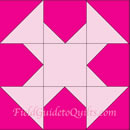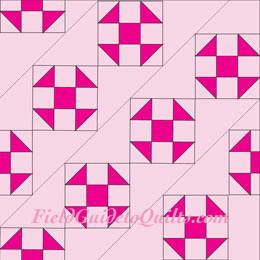Shoo Fly
 Shoo Fly
American Farmer Shoo Fly
American Farmer
1896
 The two-color, nine-patch design at left is the classic Shoo Fly block. It was first published as The Eight-Cornered Box in 1896 by The American Farmer, but that drab name is long forgotten. The two-color, nine-patch design at left is the classic Shoo Fly block. It was first published as The Eight-Cornered Box in 1896 by The American Farmer, but that drab name is long forgotten.
Shoo Fly, also spelled Shoofly and Shoo-Fly, was #276 in the Ladies Art Company's 1897 catalog. At least eight other blocks go by the same name, however. You can see the strength and simplicity of the design in the mockup at right. The design holds its own if it's made entirely of scraps, as long as they're divided into lights and darks.
No one knows how old the block is. Decades before the LAC catalog came out, a "fly fan" or "shoo fly fan" was a table-top wind-up fan that was supposed to scare away insects. The blades spun horizontally, like a ceiling fan's. The one at right is a cast-iron model with foldaway wings.
|
 Shoofly Shoofly
|
 |
At right, a Shoo-Fly Fan for the dining table. These windup fans became popular during the 19th century. The blades were horizontal to the table when they were set at the top of the center rod.
Photo courtesy of liveauctioneers.com
item 10512723
|
|
Joseph's Coat
 Joseph's Coat
Finley
1929
 Joseph's Coat
Finley
1929 Joseph's Coat in four colors Joseph's Coat in four colors
In Finley's day, quilters knew that the block was supposed to be a rainbow of colors. The block name refers to the Old Testament account of Joseph. Joseph was his father Israel's favorite child, the son of Israel's wife Rachael.
Eventually, his jealous half-brothers sold Joseph into slavery and brought back his bloodied "coat of many colors" to persuade their father that Joseph had been killed.
Joseph ended up in Egypt, became a government honcho, and married the Pharoah's daughter. Years later, when the brothers came to Egypt during a famine, Joseph, to make a long story short, forgave them. The whole family of Israel moved to Egypt. That was where their descendants stayed until Moses led their escape.
Although quilters consider the block a 9-patch, the block is laid out on a 18- by 18-square grid, according to Beyer's Quilter's Album of Patchwork Patterns. |
|
A Dandy
 A Dandy
Stone A Dandy
Stone
1906 Clara Stone's 1906 Practical Needlework included this unusual Shoo Fly variation. We've reversed the light and dark colors to show where the seamlines may have been. That's our best guess; our copy of this publication is too dark to show them. Clara Stone's 1906 Practical Needlework included this unusual Shoo Fly variation. We've reversed the light and dark colors to show where the seamlines may have been. That's our best guess; our copy of this publication is too dark to show them. |
|
|
Prairie Queen
                Prairie Queen in two colors Prairie Queen in two colors
 Prairie Queen
Finley
1929
                Prairie Queen in alternative colors Prairie Queen in alternative colors
The block is puzzling because the four 2x2 checkerboards are arranged so that one checkerboard (the bottom one in our graphic) is reversed.
As a result, multiple blocks form a lattice made up of horizontal bars with a checkerboard look and vertical bars with alternating rectangles. We've shown both styles in the whole-quilt mockups at right.
|
|
Churn Dash

Double Monkey Wrench/Old Mill Design/Hens and Chickens/Double T/Shoo Fly/Sherman's March/Monkey Wrench/Love Knot/Hole-in-the-Barn-Door/Puss-in-the-Corner/Shoo-Fly/Lincoln's Platform/Indian Hammer/Quail's Nest/Broken Plate/Joan's Doll Quilt/Fisherman's Reel/Picture Frame/Ludlow's Favorite
 Grecian Designs
Ladies Art Co., #152
1897
|
 Double Monkey Wrench
Finley 1929 |
 Churn Dash
Colors showing the basic Shoofly pattern
|
The sheer number of names for this venerable block say more about its age than anything we could. Churn Dash is the most popular. They are all made from one pattern laid out on a 6x6 grid. Some quilters will still call it a nine-patch. As long as you don't call it a four- or five-patch, you're golden.
The oldest published block in this group is Grecian Designs, from the 1897 Ladies Art Company catalog. It's the only one of these blocks that isn't usually called Churn Dash for short.
Double Monkey Wrench, from Ruth Finley's 1929 Old Patchwork Quilts, is the second oldest published name.
The third block is an example made by About.com's quilting editor, Janet Wickell. Her instructions are linked from the "Make It!" icon above.
The alternative names above are from Brackman's Encyclopedia of Pieced Quilt Patterns.
Below, an antique Double Monkey Wrench quilt.
Photo courtesy of eBay seller French72. |
 |
|
|
|
|
|
Puss in the Corner
 Puss in the Corner Puss in the Corner
Ickes, 1949The name is from The Standard Book of Quilt Making and Collecting by Marguerite Ickis (1949). The design is a four-patch (laid out on 4x4 grid).
|

Puss in the Corner |
|
Churn Dash
 Churn Dash
Ladies Art Co. #112
1897
The LAC's block #112 is a churn dash variation with rare slim proportions. It is drawn up on an 8x8 grid.
The "picture frame" names came from Clara Stone (#127) and the Kansas City Star (1955). Yvonne Khin also found it called Hole-in-the-Barn-Door and Sherman's March(Collector's Dictionary of Quilt Names and Patterns).
|
|
|
Triangles & Stripes
 Triangles & Stripes
Ladies Art Co. #229
1897 Magic Box/Squares & Stripes Magic Box/Squares & Stripes
The Ladies Art Company published this pretty variation on the Churn Dash as its #229 in 1897. The LAC offered the pattern at 13 inches and 15 cents. Or you could buy the diagram for 5 cents.
You don't even have to pay that much: You can get yours free by clicking on the "Make It!" icon. |
|
|
Fence Row Quilt
 Fence Row Quilt
Kansas City Star
1931 Fence Row Quilt
Hall
1935
Four years later, Carrie Hall published a similar block as an elongated hexagon. You make Hall's block into a full quilt by adding a half-square triangle to each end (light pink here) and setting the rows side by side).
In the Star's design, the Shoo Flys are offset about a half block. Hall's design is a checkerboard of pieced and plain blocks. It varies the look of the quilt, especially with the plain blocks in a third color.
 |
 |
 |
| Above, Hall's block with half-squares added at each end. |
Side by side Shoofly and plain blocks make a checkerboard. |
The Star's blocks, offset,
create a zigzag. |
    Fence Row (KCS) as a whole quilt Fence Row (KCS) as a whole quilt
|
|
|
|
 |
|